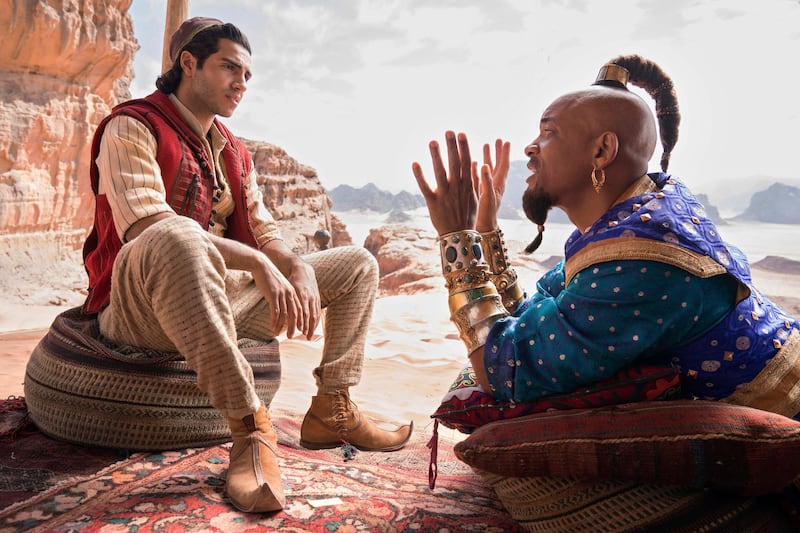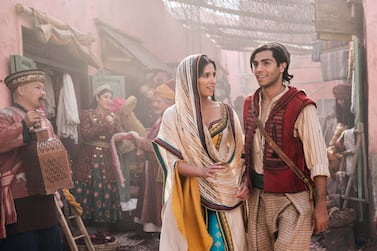The new version of Aladdin had a few things to get right to remain relevant to today's audience. However, more pressing than the use of innovative technology for the Genie was the need to erase some of the outlandish Arabic stereotypes that littered the original 1992 animated feature.
In that regard, the live-action reboot did a solid job. While there is no mistaking the heavy whiff of exoticism that flows throughout the film – it is a fantasy tale after all – there is no doubt a great deal of care was taken to ensure the movie's regional flavour was as authentic as it could have possibly been. Here are five examples:
#1: Unlike in the first film, the Arabic accent isn't used as a marker of evil
One sobering aspect of the much-loved 1992 version of Aladdin was the subtle racism that infused the film. The bad guys, often the minions of the film's ultimate villain grand vizier Jafar, had mostly thick and ugly Arabic accents, while Aladdin and Princess Jasmine had clear dulcet American tones, not to mention the fact they looked inherently western.
The new version restores that balance through an eclectic cast with backgrounds ranging from Egypt (Mena Massoud), India (Naomi Scott), Tunisia (Marwan Kenzari), Turkey (Numan Acar) and Iran (Navid Negahban and Nasim Pedrad).
The Middle Eastern-inflected accents here were not primarily used to denote violence. Instead, it was the vehicle for many sage words on forgiveness from the Sultan and justice by the kingdom's chief defender, the soldier Hakim.
Complaints that Princess Jasmine should have been portrayed by an Arab don't hold up, either. Agrabah is meant to be a rich cosmopolitan city. Scott, who herself is bi-racial, fits her character, as Jasmine's mother hails from another region.
#2: The racist lyrics from the original have been removed
Those of a certain age will remember watching Aladdin 27 years ago and being outraged at some of the lyrics included in the opening number Arabian Nights, which described Agrabah as a land "where they cut off your ear if they don't like your face" and "It's barbaric, but hey, it's home."
Fortunately, such problematic descriptors have been jettisoned in the new version.
The lyrics of the song in the remake include "You can smell every spice / While you haggle the price / Of the silks and the satin shawls" in Arabian Nights to playful hat-tips such as the mention of Ali Baba and the Genie being the "answer to your midday prayers" in Friend Like Me. In the reprise version of the song in the final credits, Smith's Genie gets more boisterous by declaring himself "Ali Baba /the big papa." It is as hilarious as it sounds.
#3: The Arabic details are actually spot on
Aladdin's sincerity to represent the region accurately was also shown in the finer details. As well as the finely rendered minarets that punctured the night sky of Agrabah, the characters' use of various written documents also feature accurate Arabic. When Jafar consults the map for The Cave of Wonders, the Arabic translation – Kahaf Al A'jaab – is spot on. And when the Genie offers to change the governing laws of Agrabah to allow Aladdin to marry the princess, the legal scroll he magically unfurls is a genuine Arab legal document spelling out the kingdom's marital laws. These are small, but meaningful details.
#4: Everywhere from Oman to Afghanistan is represented through the fashion
While Agrabah may initially seem like a sea of turbans, look deeper and you'll see some thought has been put into the film's fashion choices. With the fantastical city a rich melting point of cultures and a major business hub, the citizens all wore various styles ranging from Afghan payraans (over shirts) and Indian sarees to Omani daggers and various turbans in styles ranging from the Gulf to the wider Levant.
#5: They actually sought advice before they made it
Where the first Aladdin was lambasted by the American Arab Anti-Discrimination Committee for some of its portrayals of the region, the producers of the new version sought the advice of the Muslim Public Affairs Council (a Los Angeles advocacy and public policy organisation) to steer them away from such choppy waters. The result is a film that goes some way to changing Hollywood's perception of the Arab world.







